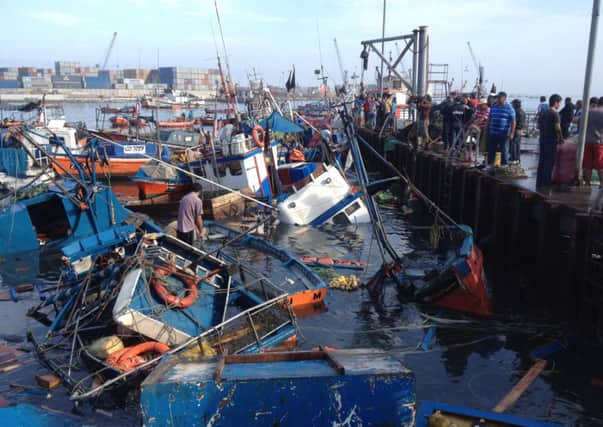Chile: Disaster areas declared after earthquake


Most were killed when they were crushed by falling objects, officials said.
Thousands of homes were evacuated yesterday after the quake struck 52 miles north-west of the mining area of Iquique, the US Geological Survey said.
Advertisement
Hide AdAdvertisement
Hide AdChile’s president, Michelle Bachelet, said the country had “faced the emergency well” and called on those in affected regions “to keep calm and follow instructions from the authorities”. She flew to the region to review the damage.
A military plane with 100 anti-riot police was sent to join 300 soldiers who had been deployed to prevent looting.
They were also involved in a search for around 300 inmates who escaped from a women’s prison in Iquique.
By last night, 26 of them had been recaptured.
The government said the declaration of a disaster area in the regions of Tarapaca, Arica and Parinacota was aimed at avoiding “looting and disorder”.
Thousands of people living on the coast fled their homes due to the threat of a tsunami. However last night the tsunami warning was stood down.
Chile’s entire coast was initially subject to the mandatory evacuation order, which lasted nearly ten hours, in coastal communities closest to the offshore epicentre of the quake.
Sea water flooded city streets and damaged or washed away many fishing boats in Iquique in northern Chile.
More than 20 aftershocks have been reported since the quake, including one measuring magnitude 6.2.
Advertisement
Hide AdAdvertisement
Hide AdThe tremors led to landslides which blocked roads, knocked out power for thousands of people, damaged an airport and started fires that destroyed businesses. Authorities last night said they had re-established electricity supply in 50 per cent of the affected areas.
Mining in Chile – the world’s top copper producing nation – was not affected, officials said.
Ms Bachelet, who was just returned to the presidency three weeks ago, tweeted: “The country has done a good job of confronting the emergency. I call on everyone to stay calm and follow the authorities’ instructions.”
She also announced that schools would be closed in evacuated areas while authorities assessed the damage.
The US Geological Survey initially reported the quake at 8.0, but later upgraded the magnitude. It was centred 61 miles north-west of Iquique.
The quake was so strong that the shaking experienced in Bolivia’s capital, about 290 miles away, was the equivalent of a magnitude 4.5 tremor, authorities there said.
Mike Simons, a seismologist at the US Geological Survey, warned: “The key point here is that this magnitude 8.2 is not the large earthquake that we were expecting for this area. We’re actually still expecting potentially an even larger earthquake.”
Chile is one of the world’s most earthquake-prone countries – just off the coast, the Nazca tectonic plate plunges beneath the South American plate, pushing the towering Andes mountain chain to ever-higher altitudes.
Advertisement
Hide AdAdvertisement
Hide AdNowhere along this fault is the pressure greater than in northern Chile, an area known as the “Iquique seismic gap”.
Mr Simons said: “This is the one remaining gap that hasn’t had an earthquake in the last 140 years. We know these two plates come together at about six, seven centimetres a year, and if you multiply that by 140 years then the plates should have moved about 11 metres along the fault, and you can make an estimate of the size of earthquake we expect here.”
The latest activity began with a magnitude 6.7 quake on 16 March that caused more than 100,000 people to briefly flee low-lying areas.
Hundreds of smaller quakes followed in the weeks since.